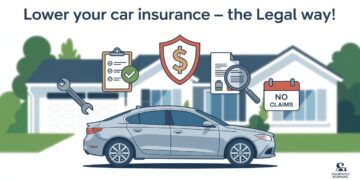Car accidents are an unfortunate reality of everyday life. In the aftermath of a collision, questions about medical bills, property damage, and liability can quickly become overwhelming. One concept designed to simplify the claims process and expedite compensation is no-fault insurance. But what exactly does this type of coverage entail? More importantly, how does it impact your rights, responsibilities, and financial security as a driver?
This comprehensive guide answers the question: What is No-Fault Insurance and How Does It Work? We will explore its origins, how it functions, where it’s applicable, and its advantages and disadvantages. Whether you’re a new driver, researching state requirements, or simply want to understand your auto policy better, this article offers all the clarity you need.
What Is No-Fault Insurance?
No-fault insurance is a type of auto insurance system in which your own insurance provider pays for your medical expenses, lost income, and other related costs after an accident, regardless of who caused the crash. This coverage is typically provided through a component known as Personal Injury Protection (PIP).
The central idea behind no-fault insurance is to reduce the number of lawsuits resulting from car accidents. Instead of having to prove another party was at fault before receiving compensation, policyholders can turn to their own insurer for prompt financial relief.
No-fault insurance was first introduced in the United States in the 1970s as a response to growing concerns about court backlogs and delays in compensating accident victims. The goal was to shift minor claims away from the judicial system, creating a more efficient and equitable way to handle personal injuries resulting from traffic collisions.
How Does No-Fault Insurance Work?
In a no-fault insurance system, each driver’s insurance company covers their own policyholder’s medical expenses and other costs related to personal injury after an accident. Here’s a step-by-step breakdown of how it works:
Step 1: Accident Occurs
Whether it’s a minor fender bender or a major collision, the first step is the same — an accident takes place. It’s crucial to report the incident to authorities and document the scene if it’s safe to do so.
Step 2: File a PIP Claim
Rather than filing a liability claim against the other driver, you file a Personal Injury Protection (PIP) claim with your own insurer. Most states have a limited window (often 30 days) to file this claim.
Step 3: Coverage Activation
Your insurer covers medical expenses, lost wages, rehabilitation costs, and sometimes even funeral expenses, up to the limits defined in your policy. Benefits vary by state and insurer but typically range between $5,000 and $50,000 in total benefits.
Step 4: Legal Threshold Review
If your injuries meet specific criteria (e.g., serious injury or a set monetary threshold), you may still be able to sue the at-fault party for damages like pain and suffering. Thresholds differ by jurisdiction and are either verbal (e.g., “significant disfigurement”) or monetary (e.g., expenses exceeding $3,000).
This system is designed to streamline payments and reduce legal delays in getting treatment and support.
What Does No-Fault Insurance Typically Cover?
No-fault insurance usually covers personal injury-related costs, including:
- Medical expenses: Doctor visits, emergency room charges, surgery, and ongoing treatment.
- Lost wages: Compensation for time missed at work due to injury.
- Rehabilitation and physical therapy: Costs for ongoing recovery.
- Household services: Reimbursement for help with tasks like cleaning or childcare if you’re unable to perform them.
- Funeral and burial expenses: Support for families in the case of a fatality.
It does not typically cover:
- Vehicle damage: This is covered under your collision insurance or the other driver’s liability coverage.
- Property damage: Damage to fences, buildings, or other property is outside PIP scope.
- Pain and suffering: Non-economic damages are only available if you meet state-defined thresholds.
Pros and Cons of No-Fault Insurance
Pros
- Faster payouts: No need to wait for fault determination or litigation. This leads to quicker access to medical care and reimbursement.
- Lower legal costs: Fewer lawsuits mean reduced legal expenses for insurers and policyholders alike.
- Reduced fraud: Clear criteria and quicker processing help minimize fraudulent injury claims.
- Predictable compensation: Easier to estimate what is covered, leading to fewer disputes.
Cons
- Limited right to sue: Pain and suffering compensation is often restricted to serious cases.
- Increased premiums: Especially in fraud-prone regions or areas with high medical costs.
- Complex thresholds: Varies by state; can be confusing and lead to denied lawsuits.
- No compensation for vehicle damage: Unless you carry collision insurance or the at-fault driver has liability coverage.
Where Is No-Fault Insurance Required?
As of this writing, 12 U.S. states and Puerto Rico require some form of no-fault insurance. These include:
- Florida
- Michigan
- New York
- New Jersey
- Pennsylvania
- Massachusetts
- Minnesota
- North Dakota
- Utah
- Hawaii
- Kansas
- Kentucky (optional no-fault system)
Each state has unique rules, so requirements and benefits may vary significantly. For example, Florida requires a minimum of $10,000 in PIP coverage, while Michigan’s PIP options now range from limited to unlimited due to recent reforms.
Types of No-Fault Systems
Pure No-Fault
Drivers are compensated by their own insurer for all injuries and cannot sue the other driver, except in rare circumstances.
Modified No-Fault
Drivers may sue the other party only if the injuries meet a defined verbal or monetary threshold.
Add-On System
Drivers can purchase no-fault benefits in addition to a traditional tort-based system. These are optional and supplement rather than replace standard liability coverage.
Choice No-Fault
Drivers choose between a no-fault and tort-based plan when they purchase insurance. This model offers flexibility but can also create confusion when filing claims.
No-Fault vs. At-Fault Insurance Systems
Feature |
No-Fault Insurance |
At-Fault Insurance |
|---|---|---|
Who pays after an accident |
Your own insurer |
At-fault driver’s insurer |
Right to sue |
Restricted |
Broad legal rights |
Claims speed |
Faster |
Slower due to investigation |
Legal costs |
Lower |
Higher due to litigation |
Common in States |
12 states + PR |
Remaining U.S. states |
Thresholds for Legal Action
Most no-fault states use a verbal or monetary threshold to determine when you can file a lawsuit against the at-fault party.
Verbal Threshold
This involves a qualitative injury standard such as:
- Permanent disability
- Significant disfigurement
- Loss of bodily function
- Death
Monetary Threshold
This involves a quantitative standard, like exceeding a certain dollar amount in medical expenses, commonly ranging from $2,500 to $5,000.
Examples:
- Florida: Serious injury threshold applies, includes significant/permanent injuries.
- Utah: $3,000 minimum medical expenses before suing is allowed.
Knowing your state’s threshold is crucial to protecting your right to pursue compensation.
Real-World Example: No-Fault Claim in Action
Imagine you’re rear-ended at a red light and suffer a neck injury. In a no-fault state:
- You file a claim with your insurer under your PIP coverage.
- Your insurer pays for your ER visit, follow-ups, and physical therapy.
- You miss work, so your policy reimburses your lost income.
- If your injury meets the state’s serious injury threshold, you may sue the at-fault driver for further damages.
No need to wait for a liability ruling — you receive essential support almost immediately.
How to File a No-Fault Insurance Claim
- Notify your insurer immediately after the accident.
- Collect all necessary documentation (medical reports, police report, wage verification).
- Submit your PIP claim form within the deadline (varies by state).
- Cooperate with your insurer: Attend medical evaluations and follow up as needed.
- Maintain detailed records: Save receipts, notes, and communication logs.
Timely and accurate filing ensures maximum compensation without delay.
Does No-Fault Insurance Affect Car Repairs?
No. Vehicle damage is handled separately through:
- Collision coverage (your policy)
- Property damage liability (other driver’s policy, if they’re at fault)
No-fault/PIP applies strictly to injuries and related expenses. If you want comprehensive protection, ensure your policy includes both collision and uninsured motorist coverage.
Frequently Asked Questions (FAQs)
What is No-Fault Insurance and How Does It Work?
No-fault insurance allows drivers to receive compensation for injuries from their own insurance company after an accident, regardless of who caused it. It typically covers medical expenses, lost wages, and other personal costs but not vehicle damage.
Can I Still Sue the Other Driver?
Yes, but only if your injuries meet your state’s serious injury or monetary threshold.
Is PIP the Same as No-Fault?
PIP (Personal Injury Protection) is the coverage mechanism used in no-fault systems. In practice, they are often used interchangeably.
Do All States Have No-Fault Insurance?
No. Only 12 states and Puerto Rico mandate it. Other states operate under traditional at-fault systems or offer optional PIP.
Does Filing a PIP Claim Raise My Premiums?
It can. Even though you’re not at fault, some insurers may increase premiums after a claim.
Is No-Fault Insurance Cheaper?
Not necessarily. While it can reduce legal costs, premiums can be higher in no-fault states due to broader PIP benefits and fraud risks.
What Happens If I’m Hit by an Uninsured Driver?
In a no-fault state, your PIP coverage still applies. However, for property damage, you’d need uninsured motorist coverage or collision coverage.
Can I Choose My Doctor?
In some states, your insurer may require you to see doctors within their approved network. Others allow more freedom of choice.
Does No-Fault Cover Passengers?
Yes. Most policies extend PIP benefits to passengers in your vehicle at the time of the accident.
Conclusion
Understanding what is no-fault insurance and how does it work is crucial for making informed decisions about your auto insurance coverage. While the system provides faster and more predictable compensation, it also comes with limitations regarding your legal rights and potential costs.
If you live in a no-fault state or are considering buying insurance that includes PIP, knowing the specifics of your policy and your state’s laws can save you time, money, and frustration after an accident.
By weighing the pros and cons, understanding how claims are handled, and staying informed about thresholds, you can ensure your protection is both comprehensive and cost-effective. Review your current policy, explore optional coverages, and consult with a licensed insurance agent to ensure your auto coverage aligns with your needs.
For many, no-fault insurance provides a valuable safety net — but only when you understand how it works and how to use it wisely.












